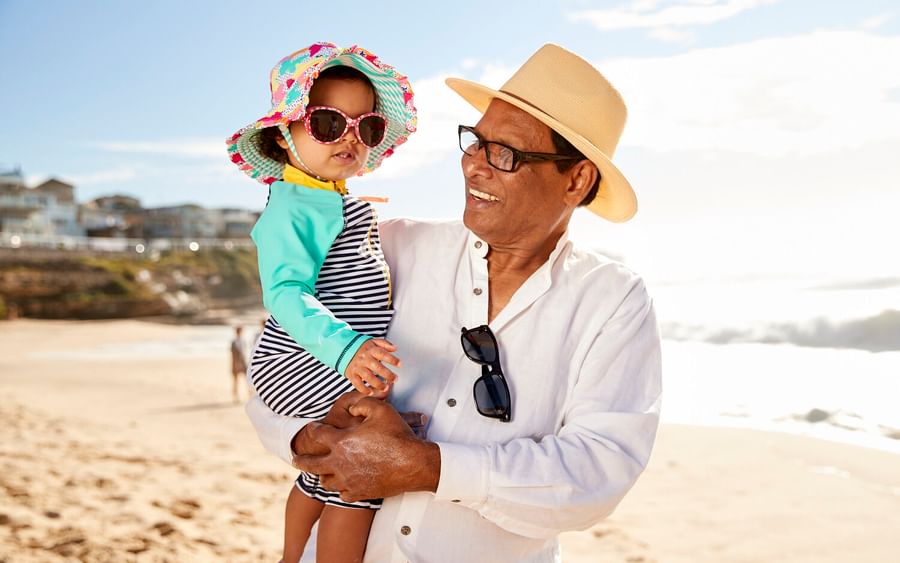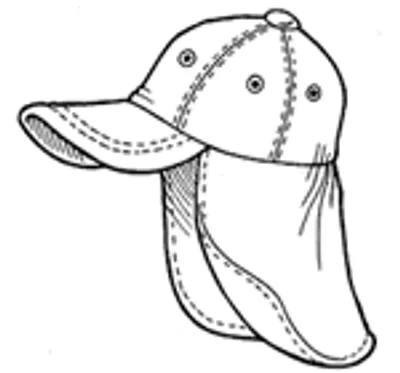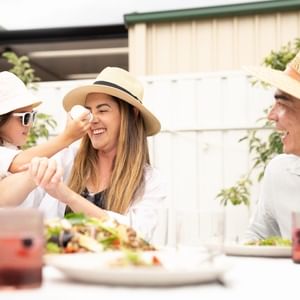When UV levels reach 3 and above, protect your skin using a combination of the five sun protection measures:
- Slip on clothing that covers as much skin as possible.
- Slop on a SPF 50 or 50+, broad-spectrum, water-resistant sunscreen 20 minutes before going outdoors, and reapply regularly.
- Slap on a hat that provides protection to your face, neck and ears.
- Seek shade where possible.
- Slide on close-fitting, wraparound sunglasses.
When should I protect my skin?
Your skin should be protected in five ways – Slip, Slop, Slap, Seek and Slide – whenever the UV Index is 3 and above.
UV radiation cannot be seen or felt. It is not like the sun’s light which we see, or the sun’s warmth which we feel as heat. Our senses cannot detect UV so it can be damaging without us knowing.
That means, weather should not be used to determine the need for sun protection. The UV can still be high on cloudy and cool days.
UV levels are affected by several factors including the time of day, time of year and cloud cover:
- In South Australia, the UV reaches 3 and above from August to May.
- UV levels reach their maximum level around midday when the sun is directly overhead.
Before heading outdoors, it’s recommended that you check the daily UV levels and recommended sun protection times using the SunSmart Global UV app or the Bureau of Meteorology.
How should I protect my skin?
When the UV reaches 3 and above, it is recommended that you protect your skin in five ways: Slip, Slop, Slap, Seek and Slide.
Slip on clothing
To reduce exposure to harmful UV, it’s recommended that you wear clothing that covers as much skin as possible.
The weave of the fabric and style of clothing is also important to consider when choosing appropriate protection. Look for:
- shirts with collars and long sleeves
- long trousers or skirts – these give you the most protection
- closely woven material – the tighter the weave, the better protection from UV radiation
- darker colours – these give slightly more protection than lighter colours but can be hotter to wear during warmer weather.
Some clothes are labelled with an Ultraviolet Protection Factor (UPF). The UPF number is a guide to how much protection the fabric provides from UV radiation. Look for a UPF 50+ for maximum protection.
Visit our Cancer Council shop to view our range of sun protective clothing.
Slop on sunscreen
When choosing a high protection sunscreen, it’s important to:
- look for a type that is labelled SPF 50 or 50+ and broad-spectrum
- choose a water-resistant sunscreen if you are planning to be active or around water
- choose the formula that suits you best such as lotions or creams -aerosol or spray sunscreens aren’t the best option as it can be hard to cover your skin properly
- check the use-by date so you don’t use a sunscreen that is out of date – while not harmful, sunscreen that has expired, will not give you proper protection against UV radiation.
- always store your sunscreen under 30°C – if left in high temperatures (such as the glove box of a car) the ingredients will separate, leaving a gritty, lumpy consistency that may affect how it is applied to skin, as well as the effectiveness of its UV protection.
Applying sunscreen
On days when the UV is 3 and above, incorporate sunscreen into your daily morning routine. Our tips for best sunscreen application are:
- Apply 20 minutes before going outdoors.
- Reapply every two hours, or more regularly if you are sweating, swimming or towel-drying. Sunscreen is only effective for a maximum of two hours at the stated SPF. Even if product says four hours water resistant, it will not provide protection for that amount of time.
- Use one teaspoon (5 ml) of sunscreen for each arm and leg, one for the back, one for front of the torso, and one for the face, neck and ears. A full adult body application is equal to seven teaspoons (35 ml) of sunscreen.
- Sunscreen products that are past their expiry date, while not harmful, will not give you proper protection against UV radiation. If they’re left in high temperatures (e.g. in the glove box of a car in the heat) the oil and water ingredients will begin to separate, leaving a gritty, lumpy consistency that may affect how it is applied to skin, as well as the effectiveness of its UV protection.
Sunscreen, even if it is reapplied regularly, cannot offer complete protection against UV radiation. Always use sunscreen in combination with other forms of sun protection.
To find out how much sunscreen you should apply, use the Cancer Council Victoria’s sunscreen calculator.
Visit our Cancer Council shop to view our range of sunscreen.
Slap on a hat
Wearing a hat provides shade to your face, neck and ears – which are common sites for skin damage, sunburn and skin cancer.
We recommend choosing a hat that has a closely woven fabric in one of the three following styles:
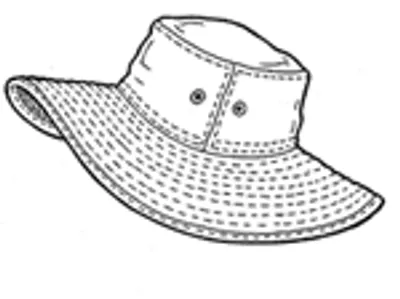
A bucket hat with a deep crown that sits low on the head and has an angled brim, which is at least 6 cm wide.
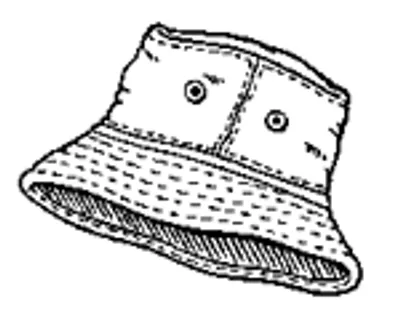
A bucket hat with a deep crown that sits low on the head and has an angled brim, which is at least 6 cm wide.
Caps aren’t suitable as they leave most of your face, and your neck and ears unprotected.
Visit our Cancer Council shop to view our range of sun protective hats.
Seek shade
Using shade when you are outdoors is an easy way to protect your skin from the sun.
Trees and man-man structures (pergolas, buildings) provide some protection from UV, but they do not totally block it out.
UV radiation can still be reflected off the ground and buildings around you even under dense shade, so always use shade in combination with clothing, hats, sunglasses and sunscreen for maximum protection.
Slide on sunglasses
UV radiation can also cause damage to the eyes, such as degenerative changes, cataracts and pterygia.
Choose protective sunglasses that:
- are close fitting, and wrap around the eyes, so that light is not let in around the frames – especially at the sides.
- meet the Australian Standard AS/NZS 1067:2016.
- have an Eye Protection Factor (EPF) of 10, which will provide almost 100 per cent UV protection
- have a protection category of two, three or four and/or a lens description that states ‘good UV protection’. (Category zero and one are fashion glasses and do not provide sufficient UV protection.)
Polarised lenses reduce glare, however do not necessarily provide protection from UV radiation. Sunglasses usually have sun protection information on the label. Look for the EPF or the protection category.
Visit our Cancer Council shop to view our range of sunglasses.
Sun protection FAQs
When should you use sun protection?
Sun protection is needed whenever the UV Index is 3 and above. In South Australia this is usually from the beginning of August until the end of April.
In Adelaide and southern parts of South Australia, UV is usually below 3 in June and July, and sun protection isn’t needed unless you work outdoors, are near reflective surfaces (like water), or outside for long periods of time. However, in some parts of the state, UV can reach 3 and above, all year round so it’s important to check your local sun protection times.
The free SunSmart Global UV app tells you when sun protection is needed at your location. Daily sun protection times can also be found at the Bureau of Meteorology website.
Why do I need sun protection on cloudy days?
Even on a cloudy day the UV index can reach and remain at 3 or above. Cloud cover does not provide sun protection as UV can pass through clouds. In fact, certain types of cloud can increase the amount of UV reaching Earth when they scatter and reflect the UV rays.
It was a cool day, so why did I get sunburnt?
Don’t assume that you’re safe in the sun, if you don’t feel it ‘sting’ your skin – that ‘sting’ or ‘bite’ you feel is the heat, not UV radiation. Sunburn can happen even on cool or cloudy days because it’s UV radiation that causes damage, not how sunny or hot the weather is. If you’re not sure, don’t risk it – download the free SunSmart Global UV app and check the sun protection times for your location.
I got sunburnt on a windy day – is it windburn or sunburn?
The answer is always sunburn. While the wind can dry your skin out, it does not cause it to burn. UV from the sun damages our skin at an index of 3 and above, so regardless of what other weather conditions are present, such as clouds or wind, remember to protect yourself from UV and Slip, Slop, Slap, Seek and Slide.
Why do outdoor workers need sun protection year-round?
Outdoor workers receive up to ten times more UV exposure than indoor workers, putting them at greater risk of skin cancer. UV exposure adds up overtime which means outdoor workers should be protecting their skin even at low levels of UV. Learn more about being SunSmart at work.
I wear a cap, that’s better than nothing right?
Whilst a cap means you have the top of your head and a small part of your forehead covered, much of your face, neck and ears are left unprotected. All of these areas are common places for skin cancer to grow. A broad-brimmed, bucket or legionnaire hat are the best styles for sun protection.
Is it safe to get a tan?
There is no safe way to tan, in fact, tanning is a sign of skin cells in trauma and not a sign of health. When skin has too much exposure to UV radiation, it produces a pigment called melanin to try to protect it from more damage. Every time your skin tans, the damage adds up to increase your risk of skin cancer. Even once the tan has faded, the damage remains.
I have naturally tanned or dark skin, do I still need to use sun protection?
Regardless of skin type, overexposure to UV radiation can damage unprotected skin This damage builds up over our lifetime and increases the risk of skin cancer developing. While people with fair skin are more sensitive to UV, all people can get skin cancer from too much time in the sun. UV radiation can also damage our eyes, lead to premature ageing and wrinkles, and even fade tattoos. Remember to protect your skin outdoors, whenever the UV is 3 and above.
As a child, I spent a lot of time outdoors, is it too late to protect my skin now?
Sun exposure in childhood plays a significant role in our future skin cancer risk, but the good news is that it’s never too late to protect your skin. UV damage adds up over your lifetime to increase your risk, but there are no ‘hard and fast’ rules to who will or won’t get skin cancer. Using sun protection at all ages is the best way to reduce your risk.
Sun protection is recommended for most of the year in South Australia, am I at risk of vitamin D deficiency?
Sensible sun protection when the UV is 3 and above, does not put people at risk of vitamin D deficiency. If you are concerned that you may be at risk of vitamin D deficiency, talk you your doctor. They can determine if dietary supplements are appropriate for your situation. Extending your time in the sun without any form of sun protection when the UV is 3 or above is not recommended, even for those with vitamin D deficiency. Prolonged sun exposure does not cause your vitamin D levels to increase further but does increase your risk of skin cancer. Learn more about vitamin D and sun protection.
How much sun is enough to make sure I get enough vitamin D?
Vitamin D levels naturally vary at different times of the year. In summer, most people make enough vitamin D because UV levels are high and we often spend more time outdoors. When the UV is 3 or above (August to the end of April in South Australia), we only need a few minutes of sun exposure mid-morning or mid-afternoon to maintain healthy vitamin D levels, even when wearing sun protection.
In June and July, when the UV level typically falls below 3, South Australians should spend time outdoors in the middle of the day with some skin uncovered to support vitamin D production. Being physically active also helps boost vitamin D levels. People who may be at risk of vitamin D deficiency should talk to their doctor for advice. Learn more about vitamin D and sun protection.
There are so many sunscreen products on the market, which is the best one to use?
In Australia, the Therapeutic Goods Administration (TGA) regulates sunscreens, to make sure that only ingredients which have been assessed for quality and safety are used. Different brands may market their products as either mineral or chemical sunscreens, both are safe and the difference is in the ingredients used and the process of protecting the skin (some physically block UV and others absorb it). There is very strong evidence that the list of commonly used active ingredients used in sunscreen in Australia are not harmful to humans.
Cancer Council SA recommends using sunscreen that is labelled SPF 50 or 50+, broad-spectrum, water-resistant and TGA approved (look for the reference that the product compiles with AS/NZS 2604:2012). As long as the product includes these requirements, the brand or ingredients you choose is up to you. You may prefer to try a few, but it’s important to find one you like as you will then be more likely to use it and reapply. For the best sun protection, use other forms of sun protection – clothing, hats, shade and sunglasses – as well as sunscreen.
What does broad-spectrum sunscreen mean?
Broad-spectrum sunscreen refers to sunscreens which filter both UVA and UVB rays. UVB is the major cause of sunburn and increased skin cancer risk, while UVA contributes to aging of the skin, as well as higher skin cancer risk. Look for an SPF 50 or 50+, broad-spectrum sunscreen for best protection and remember to use clothing, hats, shade and sunglasses to protect your skin as well.
What does the + in SPF on sunscreen mean?
The plus sign simply means ‘more than’. For example, a SPF 50+ sunscreen must be at least SPF 60 in testing in laboratories. Both SPF 50 and SPF 50+ provide a high level of protection.
What sunscreens can be used by people with sensitive skin or sunscreen allergies?
Sunscreen ingredients are similar across all brands, and sensitivities to sunscreen are complex, so simply changing the brand of sunscreen may not eliminate a reaction. A dermatologist is best placed to diagnose any reaction and help determine which ingredients should be avoided in the future.
Sunscreens that use ingredients such as zinc oxide and titanium dioxide have not been reported to cause contact allergy. However, some people do not like to use products with these ingredients as they tend to be heavier creams that do not absorb well into the skin. You may like to try a sunscreen that has been specially formulated for sensitive skin. A dermatologist will be able to provide product advice.
How can I avoid a sunscreen reaction or allergy?
As sunscreens contain multiple active ingredients, it can be difficult to determine whether you will have a reaction – and, if you do, what component of the sunscreen caused it. For this reason, Cancer Council recommends performing a usage test before applying any sunscreen, where a small amount of the product is applied on the inside of the forearm for a few days to check if the skin reacts, prior to applying it to the rest of the body.
While the usage test may show whether the skin is sensitive to an ingredient in the sunscreen, it may not always indicate an allergy, as this may occur after repeated use of the product.
If you have a known sunscreen allergy, the best way to avoid a problem is to not use any product containing the substances you are sensitive to.
